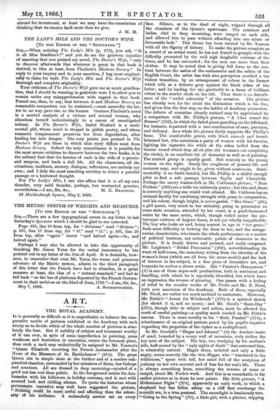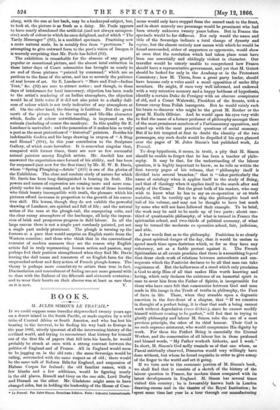ART.
THE ROYAL ACADEMY.
IT is generally as difficult as it is unprofitable to balance the com- parative merits of pictures exhibited at the Academy with such nicety as to decide which of the whole number of pictures is abso- lutely the best. But if nobility of subject and treatment worthy of it can ever, in spite of some imperfection in painting, some weakness and hesitation in execution, secure the foremost place, then such a rank may undoubtedly be assigned to Mr. Yeames's "Queen Elizabeth receiving the French Ambassador after the News of the Massacre of St. Bartholomew" (314). The great Queen sits in simple state at the further end of a sombre oak- panelled chamber, surrounded by her ministers of State, her bishops and courtiers. All are dressed in deep mourning—symbol of a grief not less real than politic. In the foreground enters the Am- bassador with his followers in holiday costume, and is met with averted look and chilling silence. To quote the historian whose picturesque narrative may well have suggested the picture, "Nothing could be more awful and affecting than the solem- nity of his audience. A melancholy sorrow sat on every face. Silence, as in the dead of night, reigned through all the chambers of the Queen's apartment. The courtiers and ladies, clad in deep mourning, were ranged on each side, and allowed him to pass without affording him one salute or favourable look." This theme has been treated by Mr. Yeames with all the dignity of history. To make the picture complete as a record of an actual event, he has not feared to grapple with the difficulty presented by the well nigh laughable costume of the
times, and he has succeeded ; for the men are more than their clothes. It may be noted that in giving full force to the con- trast between the satins of the ambassador and the sables of the
In Mr. Goodall's "Hager and Ishmael" (6) the desolate waste of sand, bounded by a weary wall of mountain, truly strikes the key note of the subject. The boy, too, trudging by his mother's side, half-scared by the "ugly sights of death" that surround him, is admirably natural. Hagar alone, unfaded and only a little angry, seems scarcely like the true Hagar, who "wandered in the wilderness," spent with toil, her mind full of the scorpions of jealousy on her own account and of fear for her son's life. There is always something keen, something the reverse of tame or insipid, about Mr. Poole's work. And this is as remarkable in his earlier pictures as in those he now paints. His little picture, "A Midsummer Night" (274), apparently an early work, in which a shepherd boy has fallen asleep on a cliff that overhangs the moonlit sea, is a true pastoral. The moonlight is luminously true. "Going to the Spring" (70), a little girl, with a pitcher, tripping
along, with the sun at her back, may be a hackneyed subject, but, to look at, the picture is as fresh as a daisy. Mr. Poole appears to have nearly abandoned the artificial (and not always unimpres- sive) scale of colour in which he once delighted, and of which "The Tardy Messenger" (83), is a modified specimen. Practising now a more natural scale, he is notably free from "prettiness." In attempting to give outward form to the poet's vision of Imogen it is scarcely surprising that Mr. Poole has failed (82).
The exhibition is remarkable for the absence of any greatly popular or sensational picture, and the almost total extinction in these latter days of Court solemnities has brought us nearly to an end of those pictures "painted by command," which are so perilous to the fame of the artist, and tax so severely the patience of real lovers of art. Sir E. Landseer's "Mare and Foal—Indian Tent," &c. (92) are sure to attract notice ; and though, in these days of intolerance for local inaccuracy, objection has been made to the artist's rendering of an Indian atmosphere, the objection would be of little value if it did not also point to a chalky dull- ness of colour which is not truly indicative of any atmosphere at all. On the other hand, the drawing is faultless. But the great merit of the picture lies in the natural and life-like character which, faults of colour notwithstanding, is impressed on the animals (including of course the monkeys). In this quality Sir E. Landseer is unrivalled ; and the possession of it makes him as truly a poet as the most pretentious of "historical" painters. Besides his indefensible Godiva and his large drawing in crayon of "A Stag and Hound" (694), he this year contributes to the Sculpture Gallery, of which more hereafter. It is somewhat singular that, compared with former times, there are now so few successful animal painters among English artists. Mr. Ansdell has not answered the expectation once formed of his ability, and has been far surpassed (not now for the first time) by Alr. H. W. B. Davis, whose "Spring Ploughing—Artois" (415) is one of the glories of the Exhibition. The close and resolute study of nature for which Mr. Davis has been long distinguished is bearing its fruit. His powers and means of expression are coming more and more com- pletely under his command, and as he is not one of those heretics who think beauty incompatible with truth, the pleasure which his pictures afford increases in proportion to the growth of his execu- tive skill. His horses, though they do not exhibit the powerful drawing of Landseer, are spirited and full of life ; and the natural action of the man at the plough-tail, the scampering colts, and the clear sunny atmosphere of the landscape, all help the impres- sion of brisk and prosperous progress in field labour. In all the large canvas there is not a single part carelessly painted, yet not a single part unduly prominent. The plough is turning up the furrows at a pace that would surprise an English rustic from the Western counties ; and those who think that in the conventional restraint of modern manners they see the reason why English artists fail in truly representing human action and passion, may perhaps feel their position strengthened when they find Mr. Davis leaving the dull teams and teamsters of an English farm for the unquenched ardour and fiery action of French plough-horses. The theory is perhaps more consolatory to artists than true in fact. Dissimulation and concealment of feeling are not more general with us than with the Italians of the fifteenth and sixteenth centuries ; and to wear their hearts on their sleeves was at least as rare then































 Previous page
Previous page